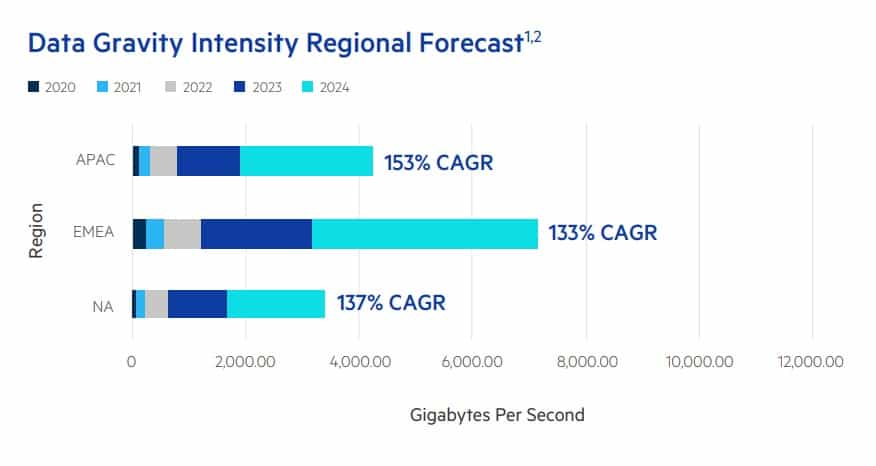Dave McCrory coined the term data gravity back in 2010 using the metaphor of gravity to explain the phenomenon of data and applications coming together in one location. Click here to watch McCrory present his ideas behind data gravity.

Data Gravity Intensity is calculated across 53 metros using the Data Gravity Index Formula: (DM x DAx BW) / L2
Data Gravity Intensity is defined by the Data Gravity Index Score. See Methodology for scoring and data.
Source: Digital Realty
As a proponent of the Data Gravity Index, what does Digital Realty, a data centre operator, have to do with data? FutureCIO spoke to Tejaswini Tilak, VP of marketing for Asia Pacific at Digital Realty for her take on digital gravity starting with a definition.
“Data gravity describes how, as data gets created, in large volumes, it attracts other data, services, and applications towards it. The problem with the effect of gravity is, it holds everything within itself, and this traps the value you get from data,” said Tilak.
Digital Realty developed the Data Gravity Index to measure and forecast this and found that APAC is the fastest-growing region – recording a 153% annual growth rate as compared to the global growth rate (139%). Of the six metros with the highest growth rates of data gravity, four are in APAC - Hong Kong, Singapore, Jakarta, and Melbourne.
How is this influencing how organisations are reconfiguring?
Tejaswini Tilak: Data flows tend to be dynamic which is why data-centric architecture is important.
Hybrid provides enterprises with the best of both worlds – the control and regulatory compliance that private deployments give, with the agility and scalability of the cloud.
Companies need a meeting place for their data, to facilitate data exchange, or even service chaining, or brokerage across multiple cloud providers, without having to transport data across continents. Therefore, they require a meeting place that is open, secure, and global.
Can you elaborate on your views regarding the need for data-centric architecture?
Tejaswini Tilak: There is advanced adoption in certain pockets of the market, but most enterprises are at the beginning stage of taking infrastructure out of what used to historically sit on-premise and moving it to the cloud. They’re adopting a cautious approach as there are risks and they won’t get the desired benefits if they simply lift and shift applications.
We are seeing developments, as well as cloud, content service and network service providers expand operations significantly in APAC because there is so much opportunity. However, in terms of relative maturity, the US is probably still much further ahead in comparison.
How can organisations continue to amass data while remaining compliant when it comes to data privacy and data protection?
Tejaswini Tilak: With regulation only going to continue in the years to come, organisations need to find a way to protect their customer data, and their metadata and make sure that when access is given to third parties, there are clear rules built into processes. Yet, innovation is hindered when organisations refuse to share their data with anyone.

"Organisations are becoming more brokers of technology, integrating multiple components to deliver applications. Data needs to be given mobility while having a control framework set up. That's where hybrid is beneficial - organisations can retain security and control while having access and data mobility."
Tejaswini Tilak
Is gravity a barrier to a digital native enterprise?
Tejaswini Tilak: From Digital Realty’s perspective, we very much think about data gravity as the barrier that companies need to overcome. We position it on the front foot as how you define data gravity because data gravity silos data. By using some of these infrastructural practices, however, you can defy that data gravity.
Is data gravity a barrier to becoming a data-centric organisation?
Tejaswini Tilak: If you think of the growth of data, it's because data has been created, applications are being created, but data about data is also being created. And then there are replicas of data that need to be stored in different places. It is sort of leading to a compounding effect in terms of the amount of data that needs to be managed.
I think the key point here is, if you do nothing with your data, it's going to get sucked by the gravity of data and it's going to get locked in to replace. You can, however, think of a data-centric architecture model and set up your underlying foundation – a foundational infrastructure to give you that mobility that you need, and the access to your ecosystem, the connectivity to your ecosystem that you need, because it is a push and pull, you do have growth of data, that data will get stuck if you don't do anything about it.
You do need to define that data gravity for it to move. And the only way to do that is to set up your infrastructure that is global and open but still secured. What we do from Digital Realty’s perspective is, we have a team of experts in this space who have come either from the industry or consulting world. They've really been doing this their whole life.
Is there a neutral starting point or something where I don't need to go look for the first consulting company out there to help me gauge where I am?
Tejaswini Tilak: That's a very interesting point, because, Digital Realty is a neutral platform. We are an open platform where we work with several vendors, such as HPE, that has an offering called Green Lake. We have partnered with them to bring the Green Lake solution to market. So first comes the core infrastructure layer, requiring collocation. Most important, is the connectivity layer on top, which comes to life through Service Fabric, Digital Realty’s virtualised platform over which they can access any of these ecosystem partners. And in that sense, we are completely neutral and open.
How do you become data-driven and data-centric, while still complying with initiatives around sustainable strategies?
Tejaswini Tilak: That is something that's very relevant to data centres. We are often blamed for consuming power, but we are almost like the central nervous system, right? We have to exist in order to support this huge growth of data.
I think the message here is there is no single provider or participant in the value chain who can solve this for you. Everyone in the ecosystem needs to review their practices and because we are looking at this synthesis, there is a stat of data that says digital transformation is potentially a US$100 trillion opportunity in terms of the amount of GDP that can be added, so it is very compelling.
What is required is continuous industry-wide dialogue and effort and we are certainly very keen to do our part.





